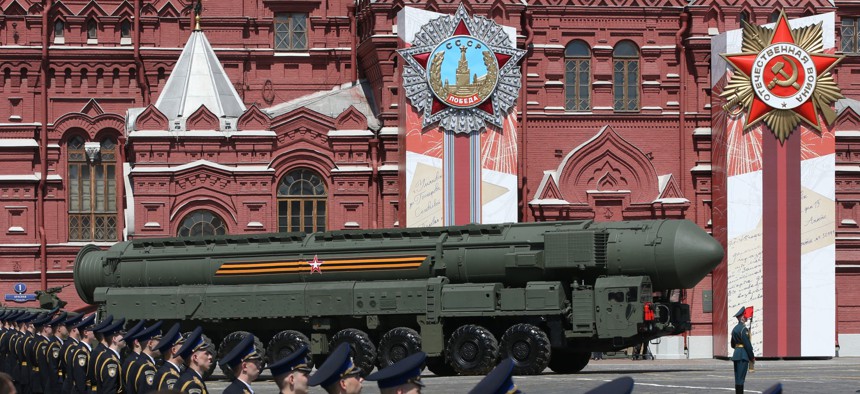
Russian nuclear missile rolls along Red Square during the military parade marking the 75th anniversary of Nazi defeat, on June 24, 2020 in Moscow, Russia. Mikhail Svetlov/Getty Images
How Biden Can Reduce the Danger of Nuclear War
The world needs more sanity and justice. Here are four steps to help avoid destroying the world.
Proportionality distinguishes sanity from insanity and justice from injustice. It would be insane to get into a gunfight over a parking space, much as it would be unjust to burn down a city to remove a dictator.
By extending the New START Treaty with Russia, President Joe Biden will signal a measure of sanity. But more must be done to reassure Americans and the world that proportionality is at the heart of the United States’ nuclear policies and posture. With adversaries that can retaliate in kind, another step the Biden administration can take immediately is acknowledging that it would be insane and unjust to use nuclear weapons against threats that are less destructive than nuclear war would probably be.
Successive U.S. administrations, including Donald Trump’s, have committed to follow the Law of Armed Conflict in their nuclear conduct. This body of law requires that combatants use the lowest level of force necessary to achieve a legitimate objective; that only military objects and personnel be targeted, not civilians; that an attack’s destruction of life and property not exceed the direct military advantage expected to be gained (proportionality), and that weapons should not cause unnecessary suffering. Unfortunately, other than the United Kingdom, the seven other nuclear-armed countries do not bother to say whether international law applies to their nuclear conduct. The United States can take the lead by demonstrating the meaning of its commitment to follow the Law of Armed Conflict and putting the onus on other states to clarify their nuclear policies. The new administration could do this by making proportionality central to U.S. nuclear policy as a legal imperative and as a general guide for thought and action.
While such proclamations of legality are welcome, the world’s nervousness over Trump’s finger on the nuclear button suggests that additional demonstrations of restraint are needed.
First, Americans must recognize how disproportionate the U.S. and Russian nuclear arsenals are to the rest of the world and try to move with Russia to reduce them. These two countries wield 91 percent of the 13,400 nuclear weapons in the world today. China and France, by comparison, have around two percent each. Most people find it unfair, if not insane, for two countries — or two individuals — to have the power to destroy the environment on which all nations depend. This is why 122 countries, in 2017, voted in the United Nations for the Treaty on the Prohibition of Nuclear Weapons, which entered into force last week. The United States and its allies and other nuclear-armed states will not join or be bound by this treaty, but American and Russian leaders need to acknowledge the unjustness of holding the rest of the world hostage to the overkill in U.S. and Russian nuclear arsenals.)
Second, U.S. leaders should make clear that they would consider using nuclear weapons only when no other means could stop an aggression that is as harmful to the United States or its allies as nuclear war would likely be. This is appropriately less vague than the longstanding position that the United States “would only consider the employment of nuclear weapons in extreme circumstances to defend the vital interests of the United States, its allies and partners.” Since no one knows whether nuclear war can be kept limited, it would only be sane or justifiable to use nuclear weapons to stop an existential attack – one that threatens the nation’s viability.
Third, to reverse the logic that leads to disproportionately large and destructive arsenals, the United States must stop seeking first-strike capabilities and plans to destroy Russia’s and China’s nuclear deterrents as implied by new intercontinental ballistic missile and missile defense systems. The U.S. defense establishment’s desire to gain such advantage is understandable, but Russia and now China will do what they must to prevent it from happening. Arms racing and crisis instability result. The ensuing costs and risks are disproportionate to the stakes involved in the regional conflict scenarios that are most likely to trigger war in the first place. Rather than build and deploy a new ICBM, or nuclear-armed sea-launched cruise missiles, or land-based intermediate range ballistic missiles, the United States should concentrate resources on enhancing its own and allied capabilities to blunt Russian or Chinese coercion below the level of open armed conflict. This is where the real threat is. Chinese leaders should be tested to demonstrate whether and how they would behave less threateningly to their neighbors if the United States acknowledged that it cannot negate China’s nuclear deterrent and will not try to do so.
Fourth, arms reductions are necessary for the United States and Russia to make the benefits of deterrence more proportionate with the costs and risks of its failure into nuclear war. If these two countries used a significant fraction of the weapons they now deploy, they could destroy not only themselves but also the environment on which innocent bystander nations depend. Arms control should seek to physically bound the potential collateral damage and long-term consequences that would occur if deterrence fails. That requires reducing both sides’ nuclear forces far below the numbers allowed under New START. Biden should declare the United States’ willingness to reduce nuclear weapons to the lowest level Russia will accept with parallel limits by China. This would shift the burden of international nuclear disarmament politics away from the United States and onto Russia and China.
The world desperately needs more sanity and justice. Biden and his team could do their part by letting the logic of proportionality drive U.S. nuclear policies and conduct, seeking reciprocity when necessary from Russia and China. The future depends on it.
George Perkovich is Ken Olivier and Angela Nomellini chair and vice president for studies at the Carnegie Endowment for International Peace. With Pranay Vaddi, he is the author of Proportionate Deterrence: A Model Nuclear Posture Review.




